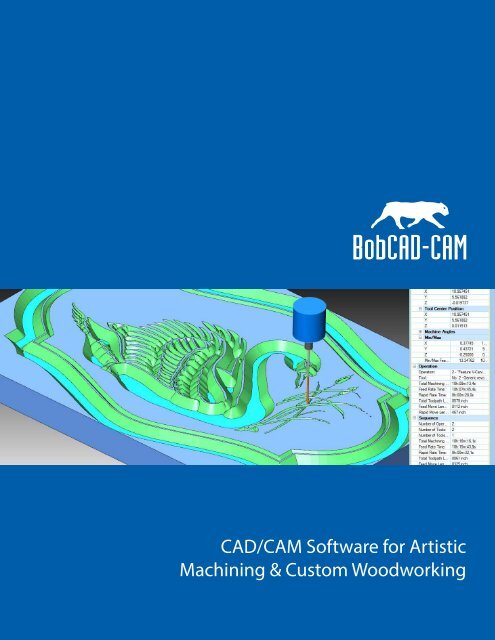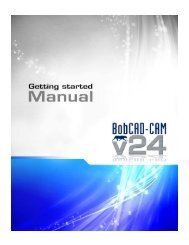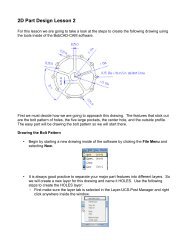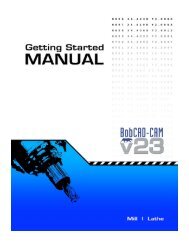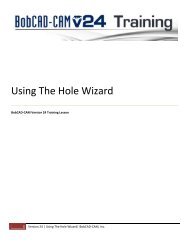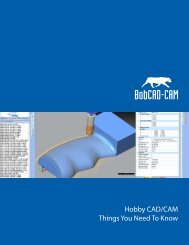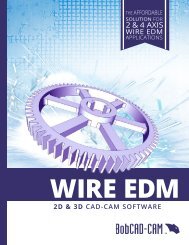Software for Artistic Machining.ai - BobCAD-CAM
Software for Artistic Machining.ai - BobCAD-CAM
Software for Artistic Machining.ai - BobCAD-CAM
You also want an ePaper? Increase the reach of your titles
YUMPU automatically turns print PDFs into web optimized ePapers that Google loves.
CAD/<strong>CAM</strong> <strong>Software</strong> <strong>for</strong> <strong>Artistic</strong><strong>Machining</strong> & Custom Woodworking
CAD/<strong>CAM</strong> <strong>Software</strong> <strong>for</strong> <strong>Artistic</strong><strong>Machining</strong> & Custom WoodworkingIntegrated CAD/<strong>CAM</strong> <strong>Software</strong> <strong>for</strong> <strong>Artistic</strong> <strong>Machining</strong>?In the not too distant past, woodworkers and designers were left with innovating their designs on paper.Thanks to the modern era of Computer Aided Design & <strong>Machining</strong> technology, these artists and designerscan now create their drawings as models that can be machined faster and more efficiently than everbe<strong>for</strong>e. However, it has not always been made af<strong>for</strong>dable enough <strong>for</strong> a home designer/machinist that istrying to start a business. At least not until recently within the last 5-10 years. As we moved out of the90's and into the new millennium, we could see costs in artistic design and machining technologyplummet to under $1000 and now, even lower. Depending on the technology you are reaching <strong>for</strong> youmight be able to per<strong>for</strong>m basic artistic functionality and simple machining <strong>for</strong> as low as $300.Professional <strong>Artistic</strong> CAD/<strong>CAM</strong> softwareallows you to take a picture or drawing andturn it into relief model or vectorizedgeometry that can be machined by a CNCMill, Router, Waterjet, Laser or Burningmachine. These products can still beacquired relatively easily and will provideenough artistic functionality to allowbeginners to become competitive insign-making and engraving quickly.Higher level products include <strong>CAM</strong> machining functionality to create complex toolpaths and numericprograms (G-Code) <strong>for</strong> machining. This article outlines the basics of CAD Design as it relates to artisticmanufacturing and det<strong>ai</strong>l how Integrated <strong>CAM</strong> (Computer Aided <strong>Machining</strong>)technology helps bringartwork to life whether it's designed <strong>for</strong> machining in wax, wood or metals.<strong>Artistic</strong> Design FunctionalityComputer Aided Design (CAD) software <strong>ai</strong>ds in the creative process by allowing the use of primitive solidshapes or points, lines, arcs, splines and other types of geometry to be used in the drawing process. Thisincludes using a User Coordinate System (UCS) <strong>for</strong> X, Y and Z geometry coordinate positioning or simplysketch features that allow <strong>for</strong> free-style draw within the software CAD workspace. This is perfect <strong>for</strong>taking an idea and turning it into a simple or complex and det<strong>ai</strong>led solid model. Typically, CAD productswill also provide text features where words can be used by selecting a font style and then writing thedesired text and positioning it in the workspace. This is beneficial <strong>for</strong> sign-making because of theengraving factor as well as the ability to use <strong>CAM</strong> technology <strong>for</strong> pocketmachining to create a r<strong>ai</strong>sed letter look to a sign.<strong>Artistic</strong> capabilities typically include the ability to import designs fromother products. These <strong>for</strong>mats will usually include file import featuresthat support extensions from programs such as Windows Photo P<strong>ai</strong>nt,Adobe Photoshop, P<strong>ai</strong>nt Shop Pro, Canon and Kodak products as well asstandard jpeg, png, bitmap and other <strong>for</strong>mats. Color pictures as well asblack and white pictures will generally be supported.1
Creating & Working With TexturesAnother important visual <strong>ai</strong>d is being able to create embossed models that are created with differenttextures, wood and even metal textures.Custom wood working applications require adatabase of wood styles such as the wood textureseen in the next image.CAD/<strong>CAM</strong> <strong>Software</strong> <strong>for</strong> <strong>Artistic</strong><strong>Machining</strong> & Custom WoodworkingWood styles like Pine, Walnut, Birch and Corkamong others are all av<strong>ai</strong>lable generally to be usedin creating textures. Different metal textures mayinclude Brushed Aluminum, Copper, Diamond Plateand many more <strong>for</strong> use in the texturing process aswell. The goal of artistic CAD/<strong>CAM</strong> AM software is toprovide the visual <strong>ai</strong>d required to see the finished result be<strong>for</strong>e machining. Ideally, there e should also beunique wood and metal types av<strong>ai</strong>lable simply by adding a color picture of one's choice into the databaseto use.Advanced texturing functionality provides the ability to create Weave textures as well as create texturesfrom images as well as primitive solids such as a sphere, cube, torus and others. Textures can also becreated from imported surface files.Basic weave textures should be easy to do. Bydefining the driving curve shape (length, peaklength and Z-height), the cross section width andother parameters programmer will be able tocreate a weave pattern as the relief. Texturedareas can be cont<strong>ai</strong>ned within and arounddesignated geometry such as a square or circle asan example.For sign making, there is the ability to merge text into the embossedpiece at specific Z depths to provide lettering. Different colors can beadded to each different component so that the user can visualize eachdifferent aspect of the project.Mirroring features are perfect <strong>for</strong> molds and castings where letteringmust be reversed. An example of this would be a mold <strong>for</strong> a plasticbottle that has text in it.4
Dynamically Using <strong>Artistic</strong> CAD-<strong>CAM</strong> To Get the BestresultsA good art program allows you to accomplish your ideas in a variety of ways. To provide maximumcapabilities the functionality should include:•The ability to emboss directly from an image•The ability to generate vector geometry from a picture <strong>for</strong> embossing•The ability to generate 2D geometry from a picture <strong>for</strong> profiling and engravingCAD/<strong>CAM</strong> <strong>Software</strong> <strong>for</strong> <strong>Artistic</strong><strong>Machining</strong> & Custom WoodworkingIn addition to these three m<strong>ai</strong>n characteristics the software should also offer the following capabilities:•Embossing from components (STL files)•Swept type features. An Emboss Swept feature creates an emboss by sweeping a cross section along openor closed geometry ch<strong>ai</strong>ns.•2 R<strong>ai</strong>l Sweep features (creating models swept along two r<strong>ai</strong>ls using one or more cross sections), sculpting,smoothing and much more.An example of the 2-R<strong>ai</strong>l Sweep is to use the two r<strong>ai</strong>ls (Geometry ch<strong>ai</strong>ns 1 & 2) and then a cross section (A,B or C geometry ch<strong>ai</strong>ns) to create the relief. This type of technique gives the programmer the ability tocustomize the and provide more det<strong>ai</strong>l.Great det<strong>ai</strong>l can be given to individual pieces of wireframe geometry. For example, circles can be used tocreate affects such as in a grape vine. In the next image you can see that 8 circles are used to create acluster of grapes and a simple closed ch<strong>ai</strong>n of entities used to create the stem part.Each of the circles is an individual embossingoperation that was Merged High ag<strong>ai</strong>nst the nextcircle starting at the bottom and moving toward thetop of the cluster. The 3D height of the embossedresult was based off of each circle radius so that theresult ended up being more of a rounded effect <strong>for</strong>each grape.5
Several different types of operations should be av<strong>ai</strong>lable within one project to bring about a much higherlevel of det<strong>ai</strong>l. The "Emboss from Image" feature is great <strong>for</strong> simple pictures. However the more complexthe picture is, the more likely that there will be a need <strong>for</strong> greater definition in the final 3D model.Custom woodworking requires the element ofembossing, carving, sculpting, smoothing andengraving that only an artistic CAD/<strong>CAM</strong> systemcan provide to make the process efficient andeasy.CAD/<strong>CAM</strong> <strong>Software</strong> <strong>for</strong> <strong>Artistic</strong><strong>Machining</strong> & Custom WoodworkingIntegrating the CAD with the <strong>CAM</strong> is a key part ofthe process as <strong>CAM</strong> will allow thedesigner/programmer to produce both 2D and 3Dtoolpath operations to machine the design.Integrated CAD-<strong>CAM</strong> in Custom Woodworking<strong>CAM</strong> technology has come a long way in the last 15 years andcontinues to offer great machining capabilities at af<strong>for</strong>dableprices. Creating toolpaths <strong>for</strong> machining requires the ability toselect geometry and then choose what strategy to use <strong>for</strong> theselection. This starts with what is called a "<strong>CAM</strong> Tree Manager".The <strong>CAM</strong> Tree Manager allows you to define tools, materials, createstock, set cutting conditions, select machining strategies <strong>for</strong>producing toolpath and a lot more. It is basically the commandstation <strong>for</strong> <strong>CAM</strong> where everything takes place and is keptorganized.In custom woodworking there may be several machining strategies that can be used such as:•Facing•Profiling•Roughing•Semi-Finishing•Finishing•REST <strong>Machining</strong>•Pencil <strong>Machining</strong>•Engraving•V-Carving and moreHole drilling is a likely necessity in sign-making type applications. There<strong>for</strong>e, it's important that everythingin use be kept organized. In addition, on-the-fly edits may take place to the design after toolpath has beencreated. Toolpath "Associativity" allows the programmer to make design changes and automaticallyupdate toolpaths. If larger or smaller tools are required, it's just a quick action to make these adjustmentsand re-generate toolpaths. Associativity eliminates the need to start over when minor changes are madeto a design after toolpath has been created.6
The <strong>CAM</strong> Tree also houses the machine Post Processor that will be used to send NC programs to specificmachine controllers. Without a "Post Processor" the <strong>CAM</strong> software is relatively useless.In this example you can see that two square boundaries exist. These are regions where toolpath will becreated. The larger boundary is <strong>for</strong> a .25 cutter where the smaller boundary cont<strong>ai</strong>ns toolpath <strong>for</strong> a smaller.125 cutter to accommodate more det<strong>ai</strong>l. The first process shows a planar toolpath used to machine thelargest area. Then a smaller Equi-Distant Offset finishing toolpath shows the more det<strong>ai</strong>led area to bemachined.CAD/<strong>CAM</strong> <strong>Software</strong> <strong>for</strong> <strong>Artistic</strong><strong>Machining</strong> & Custom WoodworkingIn the next example you can see that a High Speed <strong>Machining</strong> (HSM) toolpath was used in "A". In "B" youcan see a REST machining strategy was used to clean out and finish all of the areas that the first (larger)tool could not machine.Having a variety of toolpath types av<strong>ai</strong>lable is important because in custom woodworking, different woodshave different gr<strong>ai</strong>ns. Also, some are softer than others and easier to machine with. Toolpaths should becustomizable in terms of start and ending degrees (45, 90, etc.). This indicates the direction of themachining so that the cutting tool is made to follow the direction of the wood gr<strong>ai</strong>n.7
Here is a close up of the V-Carve and pocket operation. Here youcan see the tapered walls and the flats that are pocketed out withthe flat end mill cutter.X-Cornering is used on fonts to create that chiseled finish.CAD/<strong>CAM</strong> <strong>Software</strong> <strong>for</strong> <strong>Artistic</strong><strong>Machining</strong> & Custom WoodworkingX-cornering is where a V-Cutter is used to come in and create thetapered walls. The toolpath takes into consideration the center lineof a font. Stick fonts can also be used to create the desired look.Toolpath machining strategies can also profile or pocket around orinside of fonts to create different results <strong>for</strong> r<strong>ai</strong>sed letters.Discovering <strong>Artistic</strong> CAD/<strong>CAM</strong> <strong>for</strong> ProductivityFrom this article you should now have a good idea of how artistic CAD/<strong>CAM</strong> <strong>ai</strong>ds in custom woodworkingand turning pictures into 2D and 3D parts that can be machined. Applications range far beyond justworking with wood. This has a lot to do with the machining technology that is av<strong>ai</strong>lable in modernCAD/<strong>CAM</strong>. The design aspect is all CAD while the machining aspect is all <strong>CAM</strong>. Both sides are necessary toachieve a finished part. Providers that offer integrated CAD/<strong>CAM</strong> products typically offer core millingsoftware that also works <strong>for</strong> CNC Routing, Water Jet, Laser and Burning and includes the av<strong>ai</strong>lability of anadvanced art module or plug-in. Well developed and proven <strong>CAM</strong> products are more likely to provide awide range of machining options <strong>for</strong> machining artistic models as 3D models require complex toolpathcapabilities. There<strong>for</strong>e, when entering the discovery process <strong>for</strong> <strong>Artistic</strong> CAD/<strong>CAM</strong>, keep the abovein<strong>for</strong>mation in mind. Post Processing is also very important as the product must output the exact NCCode that your machine tool requires. Often times, a CAD/<strong>CAM</strong> provider offers services where they willcustomize the post <strong>for</strong> the user. Some integrated CAD/<strong>CAM</strong> products that are out there allow the user tocustomize the post processors themselves. This can be very beneficial with a little tr<strong>ai</strong>ning.<strong>BobCAD</strong>-<strong>CAM</strong> has provided CAD/<strong>CAM</strong> CNC <strong>Software</strong> products to the global manufacturing industry <strong>for</strong>over 25 years. <strong>BobCAD</strong>-<strong>CAM</strong> software can be found to increase CNC productivity <strong>for</strong> many applicationsincluding artistic custom woodworking, mold making, educational and independent hobby home use.Along with their family of CAD/<strong>CAM</strong> products they offer an advanced artistic module that provides all ofthe technology outlined in this article and more.<strong>BobCAD</strong>-<strong>CAM</strong> also provides a variety of quality tr<strong>ai</strong>ning and technical support solutions to theircustomers.For more in<strong>for</strong>mation on <strong>BobCAD</strong>-<strong>CAM</strong> <strong>for</strong> artistic machining and custom woodworking please call direct877-262-2231 or 727-442-3554. Visit www.bobcad.com online <strong>for</strong> free demo download software.9
World Leader In Powerful &Af<strong>for</strong>dable CAD/<strong>CAM</strong> <strong>Software</strong>28200 U.S. Highway 19 N., Suite EClearwater, FL 33761Toll Free: 877.262.2231Intl: 727.442.3554www.bobcad.com


